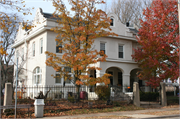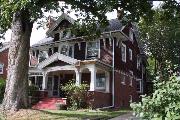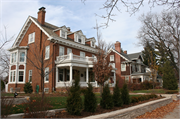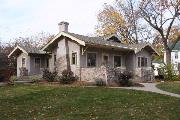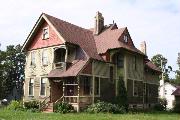1809-1845 Wauwatosa Avenue (odd only), 1907-2242 Wauwatosa Avenue, 7606 and 7624 Stickney Avenue
| Historic Name: | Wauwatosa Avenue Residential Historic District |
|---|---|
| Reference Number: | 12000354 |
| Location (Address): | 1809-1845 Wauwatosa Avenue (odd only), 1907-2242 Wauwatosa Avenue, 7606 and 7624 Stickney Avenue |
|---|---|
| County: | Milwaukee |
| City/Village: | Wauwatosa |
| Township: |
| Wauwatosa Avenue Residential Historic District 1809-1845 Wauwatosa Avenue (odd only), 1907-2242 Wauwatosa Avenue, 7606 and 7624 Stickney Avenue, Wauwatosa, Milwaukee County Dates of contributing buildings: 1844-1927 Wauwatosa was established in 1835 as Hart's Mills; it was renamed in 1842, shortly after the town of the same name was established. Among the early settlers to the area was Oliver Damon, who built a small home along the west side of present-day Wauwatosa Avenue. The roadway developed along a section line and led nearly directly into the heart of the village. Although settlement along the roadway was sparse between the 1840s and 1880, development grew in the 1880s as a number of subdivisions were created from the larger farmstead parcels. Between 1885 and 1900, the roadway truly began to develop its identifiable residential character. Specifically, the street was graded and graveled in 1898 and sidewalks were installed around the turn of the century. It was not, however, until 1919, when the street was paved with concrete. By the late 1920s, all of the lots along the Avenue had been purchased and improved, resulting in the residential, tree-lined street that is still seen today. Because of the district's nearly 80 span, its homes comprise a distinct and dense collection of high-style architecture that was popular between the 1840s and 1920s. Styles include Greek Revival, Italianate, Queen Anne, English and American Arts and Crafts and Craftsman, Georgian and Colonial Revival, as well as Italian Renaissance and Mission/Spanish Colonial Revival, with a minimum of vernacular examples. Also found within the district are three designs directly identified to published catalog or magazine plans by Gordon Van Tine, the Architects' Small House Service Bureau, as well as renowned Arts & Crafts proponent Gustav Stickley. While some modern materials have replaced the originals, the vast majority of the homes retain a very high level of historic integrity. The houses in this district are private residences, please respect the privacy of the owners.
|
| Period of Significance: | 1844-1927 |
|---|---|
| Area of Significance: | Architecture |
| Applicable Criteria: | Architecture/Engineering |
| Historic Use: | Domestic: Multiple Dwelling |
| Historic Use: | Religion: Church Related Residence |
| Historic Use: | Religion: Religious Facility |
| Historic Use: | Domestic: Single Dwelling |
| Architectural Style: | Mission/Spanish Revival |
| Architectural Style: | Queen Anne |
| Architectural Style: | Tudor Revival |
| Architectural Style: | Greek Revival |
| Architectural Style: | Bungalow/Craftsman |
| Architectural Style: | Italianate |
| Architectural Style: | Colonial Revival |
| Resource Type: | District |
| Architect: | Scott, Fitzhugh |
| Architect: | Kirchhoff, Charles |
| Architect: | Brust & Philip |
| Architect: | Leenhouts & Guthrie |
| Historic Status: | Listed in the National Register |
|---|---|
| Historic Status: | Listed in the State Register |
| National Register Listing Date: | 06/20/2012 |
| State Register Listing Date: | 08/19/2011 |
| Number of Contributing Buildings: | 31 |
|---|---|
| Number of Contributing Sites: | 0 |
| Number of Contributing Structures: | 0 |
| Number of Contributing Objects: | 1 |
| Number of Non-Contributing Buildings: | 2 |
| Number of Non-Contributing Sites: | 0 |
| Number of Non-Contributing Structures: | 0 |
| Number of Non-Contributing Objects: | 0 |
| National Register and State Register of Historic Places, State Historic Preservation Office, Wisconsin Historical Society, Madison, Wisconsin |

